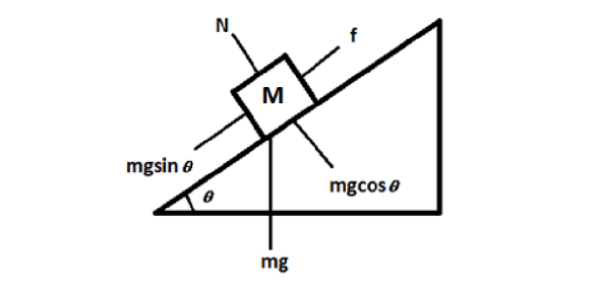Answer
384.3k+ views
Hint: First, draw a diagram, and show all the forces acting on the block along with their directions. The forces which are acting on the block are the gravitational force and its components, the normal force and the force opposing the motion of the body which is the frictional force. Using these forces and their equations, we can obtain the torque which is the cross product of force and distance.
Complete step by step solution:

Here, the block has a mass M and it is sliding down the inclined plane having an angle . The block has a side length value a, thus the value of the side length at the centre of the block would be a/2.
Now, the gravitational force on the block is acting downwards towards the ground and it is equal to mg. The two components of the gravitational force are the \[\sin \theta \] and the \[\cos \theta \] components, which are perpendicular to each other. There is also the friction component of the force acting on the block in the direction opposite to the motion of the block.
The normal force acts above the block and according to the Newton’s third law of motion, it is opposed by the cosine function of the gravitational force as
shown in the figure. Now, torque for a body is given by the formula as below:
\[\tau =r\times F\]
Here, F is the force; r is the distance of the line joining the force and \[\tau\] is the torque.
Now, from the diagram, for the motion of the body,
\[f=Mg\sin \theta \]
And hence the torque would be
\[
\tau =r\times Mg\sin \theta \\
\tau =\dfrac{a}{2}Mg\sin \theta \;
\]
Hence, option (D) is the correct answer.
Notes:Here, even though there is torque acting on the block, the motion of the block is linear towards the bottom end of the inclined plane and not rotational. This is not only because of the sine component of the gravitational force, but also because of the cosine component and the block being in contact with the inclined plane.
Complete step by step solution:

Here, the block has a mass M and it is sliding down the inclined plane having an angle . The block has a side length value a, thus the value of the side length at the centre of the block would be a/2.
Now, the gravitational force on the block is acting downwards towards the ground and it is equal to mg. The two components of the gravitational force are the \[\sin \theta \] and the \[\cos \theta \] components, which are perpendicular to each other. There is also the friction component of the force acting on the block in the direction opposite to the motion of the block.
The normal force acts above the block and according to the Newton’s third law of motion, it is opposed by the cosine function of the gravitational force as
shown in the figure. Now, torque for a body is given by the formula as below:
\[\tau =r\times F\]
Here, F is the force; r is the distance of the line joining the force and \[\tau\] is the torque.
Now, from the diagram, for the motion of the body,
\[f=Mg\sin \theta \]
And hence the torque would be
\[
\tau =r\times Mg\sin \theta \\
\tau =\dfrac{a}{2}Mg\sin \theta \;
\]
Hence, option (D) is the correct answer.
Notes:Here, even though there is torque acting on the block, the motion of the block is linear towards the bottom end of the inclined plane and not rotational. This is not only because of the sine component of the gravitational force, but also because of the cosine component and the block being in contact with the inclined plane.
Recently Updated Pages
How many sigma and pi bonds are present in HCequiv class 11 chemistry CBSE

Why Are Noble Gases NonReactive class 11 chemistry CBSE

Let X and Y be the sets of all positive divisors of class 11 maths CBSE

Let x and y be 2 real numbers which satisfy the equations class 11 maths CBSE

Let x 4log 2sqrt 9k 1 + 7 and y dfrac132log 2sqrt5 class 11 maths CBSE

Let x22ax+b20 and x22bx+a20 be two equations Then the class 11 maths CBSE

Trending doubts
Fill the blanks with the suitable prepositions 1 The class 9 english CBSE

At which age domestication of animals started A Neolithic class 11 social science CBSE

Which are the Top 10 Largest Countries of the World?

Give 10 examples for herbs , shrubs , climbers , creepers

Difference between Prokaryotic cell and Eukaryotic class 11 biology CBSE

Difference Between Plant Cell and Animal Cell

Write a letter to the principal requesting him to grant class 10 english CBSE

Change the following sentences into negative and interrogative class 10 english CBSE

Fill in the blanks A 1 lakh ten thousand B 1 million class 9 maths CBSE



